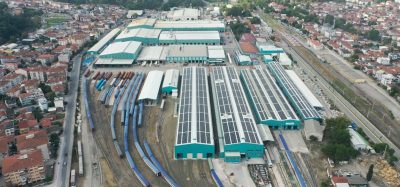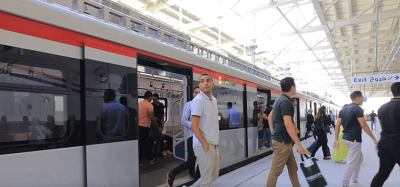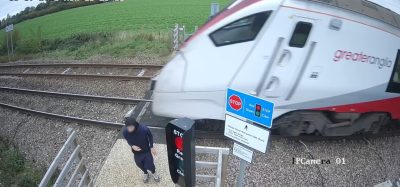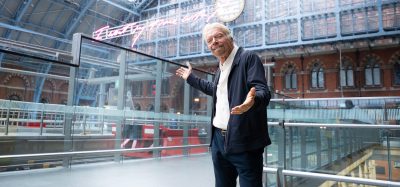Big investments in the Danish State Rail Network
Posted: 6 June 2007 | | No comments yet
Banedanmark face great challenges in the coming years. New funds from the Danish government will make it possible for Banedanmark to renew large parts of the Danish State rail network over the next seven years. Another huge challenge is a total renewal of the entire signalling system introducing an ERTMS based system in Denmark.
Banedanmark face great challenges in the coming years. New funds from the Danish government will make it possible for Banedanmark to renew large parts of the Danish State rail network over the next seven years. Another huge challenge is a total renewal of the entire signalling system introducing an ERTMS based system in Denmark.
Banedanmark face great challenges in the coming years. New funds from the Danish government will make it possible for Banedanmark to renew large parts of the Danish State rail network over the next seven years. Another huge challenge is a total renewal of the entire signalling system introducing an ERTMS based system in Denmark.
The Danish Railway has been facing great challenges over the past five years. A major part of the rail network dates back to the 60s and 70s and despite great efforts to maintain the network, the poor condition of tracks, signals and other infrastructure elements have caused major problems for train traffic across the country.
The problems come at a time when the need for transport in Denmark is constantly and rapidly increasing. Statistics show that the population’s need to move over longer distances is growing. Though the number of train passengers being transported on the Danish rail network has increased over the last 10 years, the increase in road traffic has been even larger. It is therefore urgent that something has to be done about the rail network in order to make train transport more attractive, not least for environmental reasons.
Join our free webinar: Rail cyber-security in a time of technological and regulatory transformation
Join our expert panel, including speakers from Nokia and Siemens Mobility, to explore the critical convergence of cybersecurity and 5G rail comms.
Date: 3 Dec | Time: 15:00 GMT
Can’t attend live? No worries – register to receive the recording post-event.
Worn down infrastructure
In order to keep up safety, trains have been subject to speed reductions on a regular basis over the past years due to safety critical failures in the track, leading to large delays for train passengers and a general dissatisfaction with train transport as a whole. As a consequence, the reputation of the railway sector is suffering.
Though the poor condition of the infrastructure does not lead to safety problems, the run-down infrastructure does cause problems for train punctuality, mainly because speed reductions are imposed in order to keep up safety. Furthermore, unevenness in tracks causes a less comfortable ride for both passengers and train crew.
The problems with the poor condition of the tracks increase during summer season as the combination of old tracks and warm weather involves a higher risk of buckling of the tracks due to high temperatures. Thus, the last couple of summers have caused great problems for the Danish train passengers.
Large investments in infrastructure
Banedanmark spent most of 2006 analysing the state of the infrastructure with the help of international experts. Their conclusion was that a significant back-log had been built up over the years and that large scale investments were needed if punctuality of the trains was to improve – or in some cases to simply keep sections of the network open to traffic.
In the autumn of 2006, after yet another summer with major problems for train traffic, the Danish government made an important decision based on the previously mentioned analysis. They decided on a financial package which will secure the possibility for continued renewal of the Danish State rail network over the next seven years by awarding an additional DKK 4 billion in the years 2007 to 2014. Banedanmark has thereby been given the opportunity to achieve one of our key objectives: to provide a rail network that does not prevent train operators from making their trains run on time.
The additional financing increases over the years and will primarily be used for renewal of tracks, bridges, traction current, infrastructure related buildings, IT and transmission. The prioritisation of the effort follows a carefully selected principle that has been decided upon politically, namely that the sections of the network that carry the largest numbers of passengers and trains will be prioritised first, whereas sections that have low passenger and train numbers are postponed until later in this period or in a subsequent period. The background for this approach is to have a clear plan for how to bring up to date a generally worn down network and to avoid that e.g. lobbyism or occasional incidents will lead to random priorities.
Busier than ever
Due to the large investments in infrastructure, the next seven years on the rail network will be busier than ever. First of all, our focus will be on renewing the tracks. During the next seven years, we will renew 42% (1,300km) of the track. But we will also renew 800 bridges and 600km of ditches. Besides, part of the traction current and the transmission network will be renewed.
Long term planning
Our great advantage is that we now have a long term investment plan. This makes it possible for us to plan the infrastructure projects on a long term basis which has several positive consequences. First and foremost, it gives us the possibility in cooperation with train operators to plan how train traffic should run while the renewal takes place. Moreover, we can invite tenders for projects long time in advance and bundle together relevant projects in order to obtain more advantageous bids and thereby completing the projects at the lowest possible price. That way we will make sure that we get as much out of the financial means as possible.
Our first step has been to plan our effort for the next three years. In regard to the rest of the period, we already know in broad outline which parts of the infrastructure we will renew but the actual detailed planning of the work will be carried out at a later point.
Last year we renewed two important sections of the rail network close to Copenhagen. This summer, we will be renewing tracks on two of the most important sections of the network in the larger Copenhagen area. One of the lines is Køge Bugt banen, a city line with 18.5 million travellers every year, the other is a regional line that serves 10 million travellers yearly North of Copenhagen. Moreover, the latter is connected with the line that serves passengers between Denmark and Sweden which is another reason why the work on this section of the rail network is of such great importance.
When the next three years have passed, we will be over the worst back-log on track renewal and maintenance, and on our way towards a better functioning rail network.
New signalling systems
A back-log has not only been built up on the tracks over the years. An increasing number of failures due to ageing signalling systems have also been a major concern for Banedanmark in recent years. However, to our great content the Danish government last autumn also made a decision in principle to move along with a total renewal of the entire signalling system in Denmark.
And the situation is indeed serious. In 2005, approximately 50% of all train delays caused by infrastructure are due to signalling failures. In the last five years, the number of failures has been increasing. Last year, the number of failures on the mainline was as high as 17.555 – a thousand more than the year before. The explanation is old signalling and interlocking-equipment, consisting of many different types and technologies often causing untraceable failures. About 85% of our signalling systems are more than 20 years old. One third is more than 40 years old and we still use equipment that was in its prime during the Second World War. Further challenges are high maintenance costs, few employees that understand the old systems, cross country problems and Danish ATC reaching its end of life in 2020.
A crucial decision
Something really needed to be done. In 2006 – after one year of hard work – Banedanmark in cooperation with Booz Allen Hamilton presented a thorough analysis to the Danish government. The analysis investigated three different scenarios for the Danish signalling systems; ongoing maintenance and renewal, intensified maintenance and renewal and total renewal. In addition, two further scenarios combining the three.
Last autumn the government decided on a total renewal of the lines based on ERTMS level 2 before the year 2020 (alternatively 2018). Funds will be granted in autumn 2008, when Banedanmark presents a detailed project plan. After an EU-tender Banedanmark has chosen the Danish advisor Rambøll A/S and the Swiss advisors Emch and Berger AG and R Burger and Partner AG, to help prepare the basis of decision for the Danish politicians.
For the last six months Banedanmark has been busy organising the Signalling Programme. We have established a dedicated and skilful programme organisation with a team of 25 employees. Right now, they are busy preparing technical solutions, risk analysis, procurement and investment plans and in cooperation with Trafikstyrelsen – the National Rail Authority – to set up operational rules for the introduction of ERTMS in Denmark.
The roll-out
According to the present time schedule, Banedanmark expects to sign contracts with two or three suppliers in the year 2010/11. The main roll-out is expected to begin around 2014 and the implementation will be finalised in 2018-20.
But what about the train traffic and the train delays until then? The Booz Allen analysis agrees that the Danish signalling and interlocking systems are old, but well maintained and with high maintenance until the roll-out of ERTMS, most of them can still last another 10 years.
And though we have to wait, the total renewal is worth waiting for. ERTMS really is the cross border signalling system of the future. It will give us higher capacity and better punctuality, interoperability and the same high level of safety everywhere.
It will of course be a huge challenge for Banedanmark to carry out major works on both signalling systems and tracks while keeping trains running. But it is an investment in the future and a challenge we look very much forward to taking up.
About the author
Eigil Sabroe started his working life with the DSB in 1966. After a five-year internal education, he went on to work for the DSB Freight Division in various positions. During his time there he graduated in marketing and sales. From 1988 until 1993, Mr Sabroe was chairman of the trade union representing employees at the railways. From 1993, he worked as manager of traffic control in the DSB. When Banestyrelsen was separated from the DSB and established as a separate public administration in1997, Mr Sabroe was appointed Director of Traffic Management. From 2002 he was also Director of IT & Telecom. From 2004 he is the Chief Technical Officer in Rail Net Denmark.
Stay Connected with Global Railway Review — Subscribe for Free!
Get exclusive access to the latest rail industry insights from Global Railway Review — all tailored to your interests.
✅ Expert-Led Webinars – Gain insights from global industry leaders
✅ Weekly News & Reports – Rail project updates, thought leadership, and exclusive interviews
✅ Partner Innovations – Discover cutting-edge rail technologies
✅ Print/Digital Magazine – Enjoy two in-depth issues per year, packed with expert content
Choose the updates that matter most to you. Sign up now to stay informed, inspired, and connected — all for free!
Thank you for being part of our community. Let’s keep shaping the future of rail together!
Issue
Related topics
European Rail Traffic Management System (ERTMS), Infrastructure Developments, Signalling, Control & Communications







